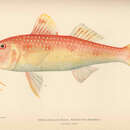Diagnostic Description
provided by Fishbase
A series of three large blackish blotches on upper side of body beneath dorsal fins; color variable but usually pale, the scales of the back with reddish or yellowish brown edges and a central pale blue spot; diagonal light blue lines on head. Capable of displaying a pattern of large red blotches on head and body in less than a minute (Ref. 13442).
- Recorder
- Grace Tolentino Pablico
Life Cycle
provided by Fishbase
Spawnng may either be in pairs or in small groups (Ref. 240).
Morphology
provided by Fishbase
Dorsal spines (total): 89; Dorsal soft rays (total): 8
- Recorder
- Grace Tolentino Pablico
Trophic Strategy
provided by Fishbase
Inhabits shallow waters to depths of 90 m (Ref. 9626), especially over sand and rock bottoms in reef areas. Young juveniles often found on beds of seagrass, e.g. Thalassia. Feeds on small invertebrates (Ref. 9626). Grubbers which excavate while moving, feed on bottom animals (Ref. 40396). Microinvertivore (Ref. 33499). Mobile invertebrate feeder (Ref. 126840).
Biology
provided by Fishbase
Inhabits shallow waters to depths of 90 m (Ref. 9626), especially over sand and rock bottoms in reef areas. Young juveniles often found on beds of seagrass, e.g. Thalassia. Feeds on small invertebrates (Ref. 9626). Flesh highly esteemed; marketed fresh and frozen (Ref. 3792). Traded as an aquarium fish at Ceará, Brazil (Ref. 49392).
Importance
provided by Fishbase
fisheries: commercial; aquarium: commercial
Pseudupeneus maculatus
provided by wikipedia EN
Pseudupeneus maculatus, the spotted goatfish, is a species from the family Mullidae.[1][2][3][4] The species was originally described by Marcus Elieser Bloch in 1793.[2] It occurs in the western Atlantic Ocean.[1][2]
References
-
^ a b c Dooley, J.; Aiken, K.A.; Collette, B.; Marechal, J.; Pina Amargos, F.; Kishore, R.; Singh-Renton, S. (2015). "Pseudupeneus maculatus". IUCN Red List of Threatened Species. 2015: e.T16545086A16546282. doi:10.2305/IUCN.UK.2015-4.RLTS.T16545086A16546282.en. Retrieved 12 March 2022.
-
^ a b c d Eschmeyer, William N.; Fricke, Ron & van der Laan, Richard (eds.). "Pseudupeneus maculatus". Catalog of Fishes. California Academy of Sciences. Retrieved 12 March 2022.
-
^ Andrey Soares; Alex S Lira; Júlio Guazzelli Gonzalez; Leandro N Eduardo; Flávia Lucena-Frédou; François Le Loc'h; Beatrice Padovani Ferreira; Thierry Frédou (13 May 2020). "Feeding habits and population aspects of the spotted goatfish, Pseudupeneus maculatus (Perciformes: Mullidae), on the continental shelf of northeast Brazil". Scientia Marina. 84 (2). doi:10.3989/SCIMAR.04958.24A. ISSN 0214-8358. Wikidata Q109779315.
-
^ "Pseudupeneus maculatus". iNaturalist. Retrieved 2021-11-28.
 Media related to Pseudupeneus maculatus at Wikimedia Commons
Media related to Pseudupeneus maculatus at Wikimedia Commons

- license
- cc-by-sa-3.0
- copyright
- Wikipedia authors and editors
Pseudupeneus maculatus: Brief Summary
provided by wikipedia EN
Pseudupeneus maculatus, the spotted goatfish, is a species from the family Mullidae. The species was originally described by Marcus Elieser Bloch in 1793. It occurs in the western Atlantic Ocean.
- license
- cc-by-sa-3.0
- copyright
- Wikipedia authors and editors
Distribution
provided by World Register of Marine Species
Western Atlantic: Bermuda and New Jersey, USA to Rio de Janeiro, Brazil; including the Gulf of Mexico and throughout the Caribbean Sea
North-West Atlantic Ocean species (NWARMS)
- license
- cc-by-4.0
- copyright
- WoRMS Editorial Board
Habitat
provided by World Register of Marine Species
benthic
North-West Atlantic Ocean species (NWARMS)
- license
- cc-by-4.0
- copyright
- WoRMS Editorial Board


![]() Media related to Pseudupeneus maculatus at Wikimedia Commons
Media related to Pseudupeneus maculatus at Wikimedia Commons